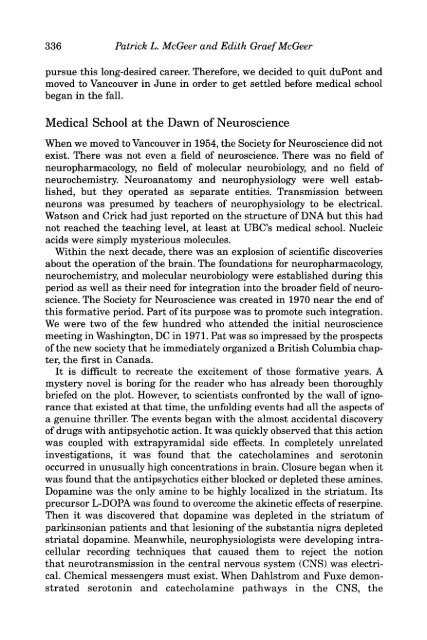Edith Graef McGeer - Society for Neuroscience
Edith Graef McGeer - Society for Neuroscience
Edith Graef McGeer - Society for Neuroscience
Create successful ePaper yourself
Turn your PDF publications into a flip-book with our unique Google optimized e-Paper software.
336 Patrick L. <strong>McGeer</strong> and <strong>Edith</strong> <strong>Graef</strong><strong>McGeer</strong><br />
pursue this long-desired career. There<strong>for</strong>e, we decided to quit duPont and<br />
moved to Vancouver in June in order to get settled be<strong>for</strong>e medical school<br />
began in the fall.<br />
Medical School at the Daw^n of <strong>Neuroscience</strong><br />
When we moved to Vancouver in 1954, the <strong>Society</strong> <strong>for</strong> <strong>Neuroscience</strong> did not<br />
exist. There was not even a field of neuroscience. There was no field of<br />
neuropharmacology, no field of molecular neurobiology, and no field of<br />
neurochemistry. Neuroanatomy and neurophysiology were well established,<br />
but they operated as separate entities. Transmission between<br />
neurons was presumed by teachers of neurophysiology to be electrical.<br />
Watson and Crick had just reported on the structure of DNA but this had<br />
not reached the teaching level, at least at UBC's medical school. Nucleic<br />
acids were simply mysterious molecules.<br />
Within the next decade, there was an explosion of scientific discoveries<br />
about the operation of the brain. The foundations <strong>for</strong> neuropharmacology,<br />
neurochemistry, and molecular neurobiology were established during this<br />
period as well as their need <strong>for</strong> integration into the broader field of neuroscience.<br />
The <strong>Society</strong> <strong>for</strong> <strong>Neuroscience</strong> was created in 1970 near the end of<br />
this <strong>for</strong>mative period. Part of its purpose was to promote such integration.<br />
We were two of the few hundred who attended the initial neuroscience<br />
meeting in Washington, DC in 1971. Pat was so impressed by the prospects<br />
of the new society that he immediately organized a British Columbia chapter,<br />
the first in Canada.<br />
It is difficult to recreate the excitement of those <strong>for</strong>mative years. A<br />
mystery novel is boring <strong>for</strong> the reader who has already been thoroughly<br />
briefed on the plot. However, to scientists confronted by the wall of ignorance<br />
that existed at that time, the unfolding events had all the aspects of<br />
a genuine thriller. The events began with the almost accidental discovery<br />
of drugs with antipsychotic action. It was quickly observed that this action<br />
was coupled with extrapyramidal side effects. In completely unrelated<br />
investigations, it was found that the catecholamines and serotonin<br />
occurred in unusually high concentrations in brain. Closure began when it<br />
was found that the antipsychotics either blocked or depleted these amines.<br />
Dopamine was the only amine to be highly localized in the striatum. Its<br />
precursor L-DOPA was found to overcome the akinetic effects of reserpine.<br />
Then it was discovered that dopamine was depleted in the striatum of<br />
parkinsonian patients and that lesioning of the substantia nigra depleted<br />
striatal dopamine. Meanwhile, neurophysiologists were developing intracellular<br />
recording techniques that caused them to reject the notion<br />
that neurotransmission in the central nervous system (CNS) was electrical.<br />
Chemical messengers must exist. When Dahlstrom and Fuxe demonstrated<br />
serotonin and catecholamine pathways in the CNS, the











![[Authors]. [Abstract Title]. - Society for Neuroscience](https://img.yumpu.com/8550710/1/190x245/authors-abstract-title-society-for-neuroscience.jpg?quality=85)





